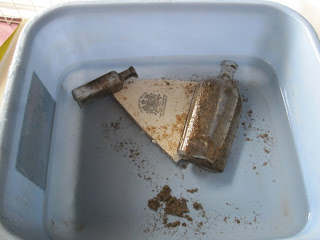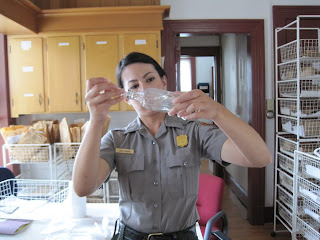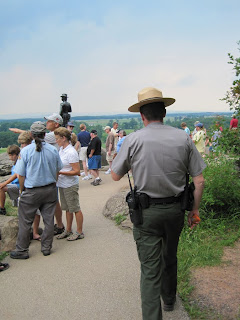
A view of the battlefield from Gettysburg NMP.
Tuesday, I began my time in Resource Management by spending the day with Bert Herbert, our park's archaeologist. As I mentioned before, I was excited for the opportunity - because I'd finally have someone to "talk shop" with.
From my limited time with Bert, I gleaned that the park archaeologist in Gettysburg primarily works to protect the resources through ensuring compliance. This means that when our battlefields or properties are potentially disturbed, he steps in and acts as an overseer and consultant.
In fact, our first activity of the day was in relation to this exact function.
Our Spangler's Spring comfort station had been closed for some time due to the fact its 30's-era water line had become non-functional over the years. This year, the park is beginning a construction project to replace it and thereby reopen the comfort station. To give a simplistic explanation of the situation: The park intends to replace the water line by digging in the exact path of the old water line, replacing it in kind. Because the survey team discovered that the water line runs beneath a number of our park's defensive walls, and would require their being disturbed - it required a field visit from Bert.
Bert and I walked the entire length of the old water line, chasing the occasional blue line across the tall grass of the fields. At one point, we even had to venture straight into deep, overgrown thicket. Even though it was still early morning, it was about 90 degrees out and very humid. Trying to make my way through that thicket was probably the most intense hiking I've ever done in my life. If you're ever around some thicket and are curious about venturing off trail, I wouldn't recommend it. There's just too many plants with thorns and tangly vines and roots.

Blue line hunting in the thicket! You can see the trail we were following in the lower right hand corner, painted on a plant.

The water line intersecting one of our defensive walls.
Finally, we came to the tail end of the water line, and documented the path photographically. I later learned from Bert that this water line was originally dug by hand. Hand-dug trenches can be made to be very narrow and are much easier to "shape." This means that when our machines come in to "replace in kind", they have to be just as precise as the original scope of the labor in order not to disturb areas outside of the original trenches, so that the integrity of the battlefield is maintained. Extraordinary care will be necessary as the crews get near the walls and monuments, as well. Construction and preservation of historic sites is a very delicate thing. on one hand, you want to maintain and make accessible your resources - but on the other hand, once you've tampered with the original integrity of a historic resource, it can never be regained.

Bert and Dan (the supervisor for the project) meet to discuss the importance of using a very small diameter backhoe bucket and an experienced operator for the delicate excavation, and the best methods to preserve the integrity of the battlefield during the project.
After lunch, I was allowed to go into the wet lab and assist with the cleaning of artifacts that had been discovered at one of our building preservation sites, the Klingel house.
Cleaning the patent medicine bottles and broken plate was difficult. They were literally caked with hundred-year old mud that had hardened into a cement-like consistency, yet still demanded the kind of delicate handling an artifact ought to receive. I also was forbidden to use soap (for obvious reasons), so it was just me and a basin of water, primarily.

Water and a bucket. My tools for the afternoon also included a cup full of toothbrushes, pipe cleaners, cotton swabs, and tissues.

I invented a new tool to clean the bottle. I call it the field-expedient cottonswab and pipe cleaner apparatus - or FE-CAPCA - because I've also learned that the government really likes initialisms and acronyms

Generally, you can't use water on metal. Instead, dry brushes (seen on the right hand side of the picture) are used. The artifacts here are two nails and what I thought was a bell, but Burt said could also be some kind of censer (a kind of receptacle for burning incense).

This inscription, located on the back of a spoon handle, became visible once I cleaned the dirt off of it. It appears to say "RITAN" and has an image of what is either a crown of a chef's toque, and some small letters beneath. "KET", maybe? My guess is that it said PURITAN at some point in time.

"Guaranteed full 1/2 pint"! All clean. Thanks, FE-CAPCA.

Nothing like a basket of clean artifacts at the end of a day. These will eventually be cataloged and then make their way into storage at curation (which you can see in one of my earlier posts), but for now they have to dry.
Trying to strike that balance between conservation/protection and public use is probably the most complicated issue I've come across in my time at the park so far - and after spending the day with Winona Peterson (more on that later), one of our park's historians, I'm convinced there's no easy solution. The visitors come to see the resource - but visitor use can sometimes threaten the resource. Without visitors, there is no park - but without resources, there are no visitors.
Visitors enjoying Little Round Top; Ranger Ryan Levins patrolling.
I think the best thing that I can do as a LE ranger, then, is not just to demand rule compliance as if it were some grand arbitrary fiat - but rather take a page from the interp rangers and do some education. If visitors cutting social trails down the face of Little Round Top is causing the hill to erode (which they are - and it is), then it's probably beneficial to take them aside and tell them: "Hey, I understand you love this place and want to see more of it, but we only get one chance to preserve history. We get over a million and a half visitors in a year, and if they all walk down the side of the hill, then there's not going to be anything left of Little Round Top in the future." Or something like that.
Of course, sometimes people won't listen to you, or don't care, and in that case I don't think there's not much to do aside from punishing the violation by whatever means are appropriate for the situation. But discounting that, I think most people are reasonable and appreciate being treated as such. I'll definitely have to do more observations of conflict resolution styles, though. I've still got a lot (and by a lot, I mean everything) to learn!



No comments:
Post a Comment